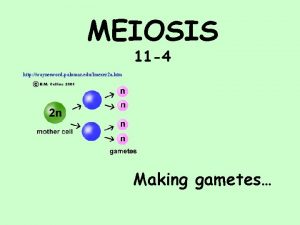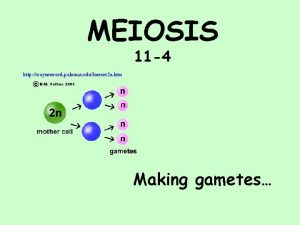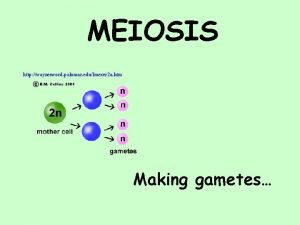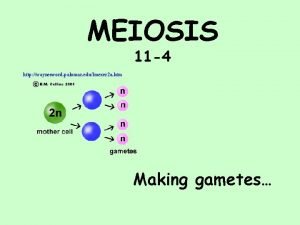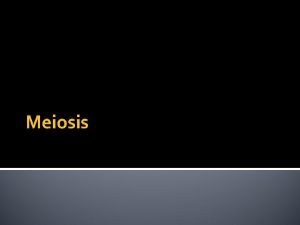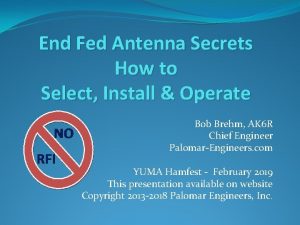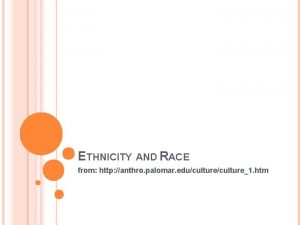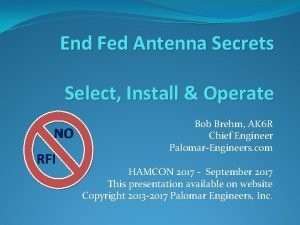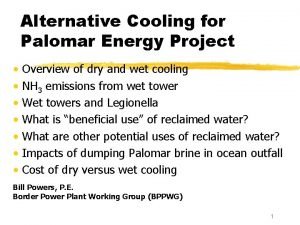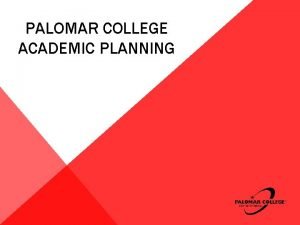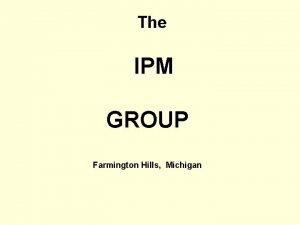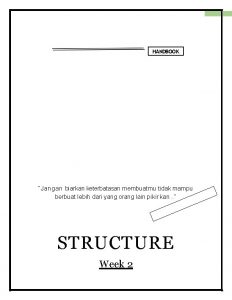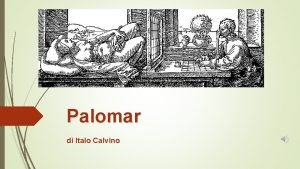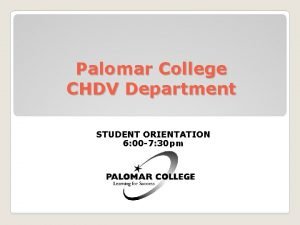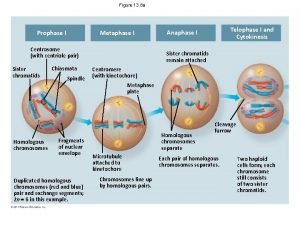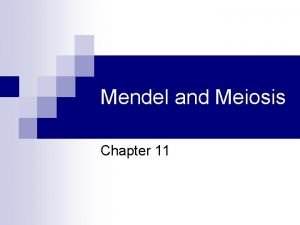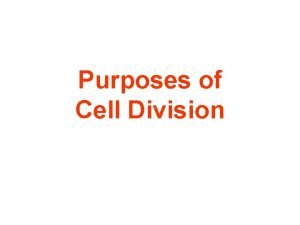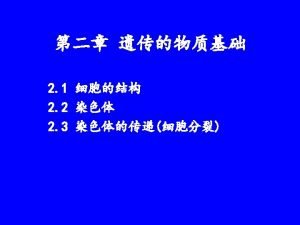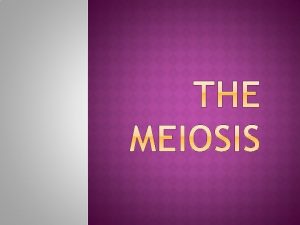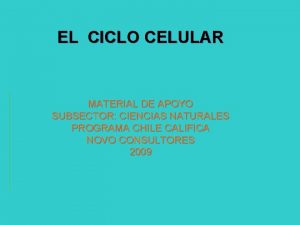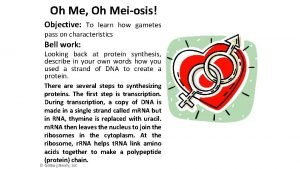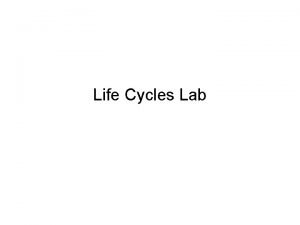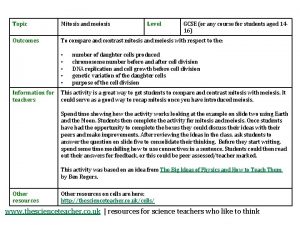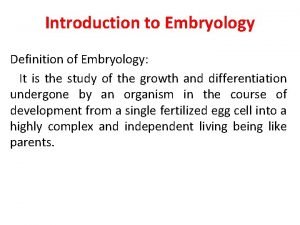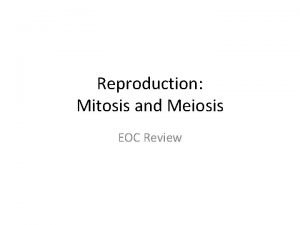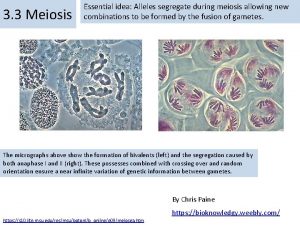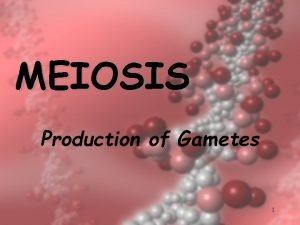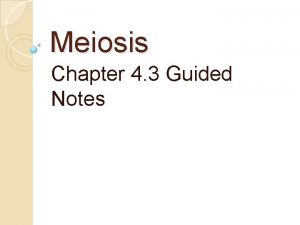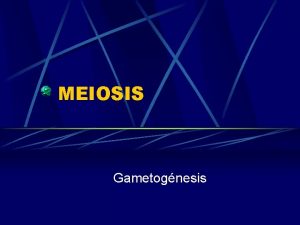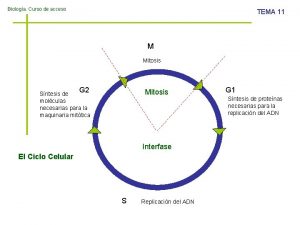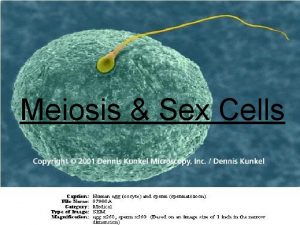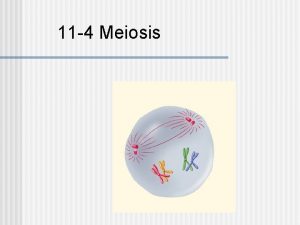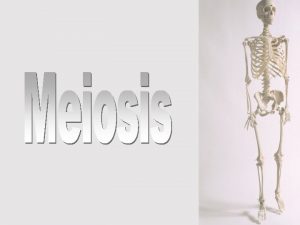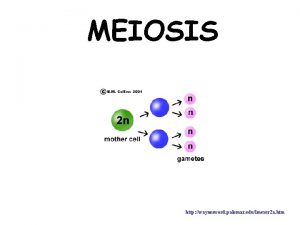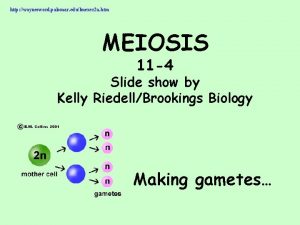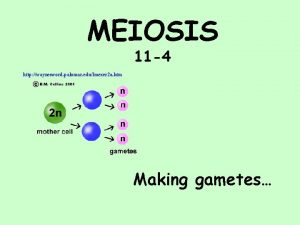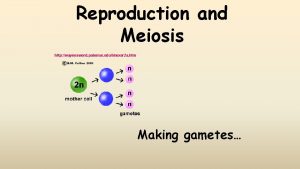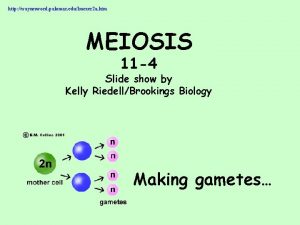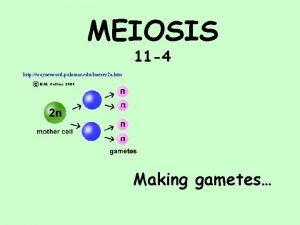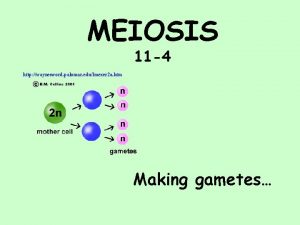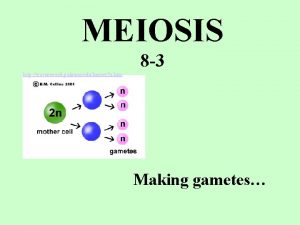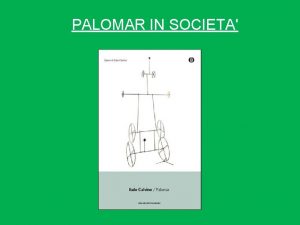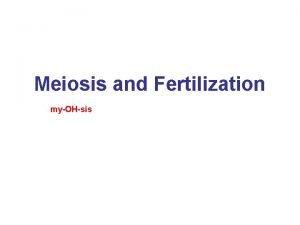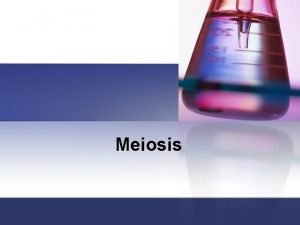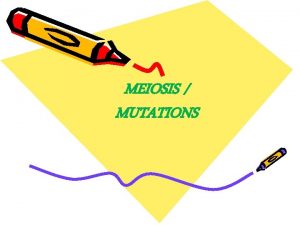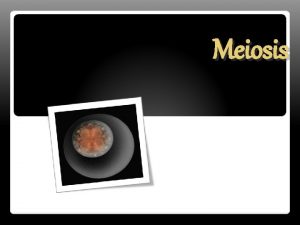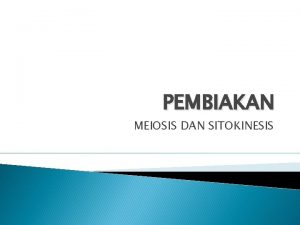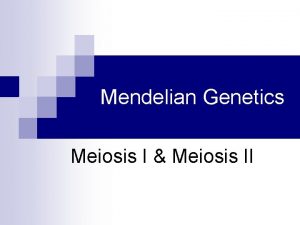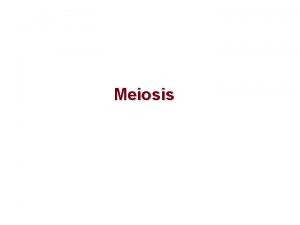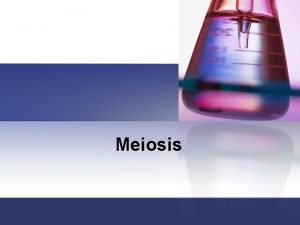MEIOSIS 11 4 http waynesword palomar edulmexer 2




















































- Slides: 52

MEIOSIS 11 -4 http: //waynesword. palomar. edu/lmexer 2 a. htm Making gametes…

Remember from Chapter 1: CHARACTERISTICS OF LIVING THINGS ALL LIVING THINGS _____ Planaria animation: http: //www. t 3. rim. or. jp/~hylas/planaria/title. htm Family http: //babyhearing. org/Parenet 2 Parent/index. asp

ASEXUAL REPRODUCTION Bacteria reproduce using http: //www. emc. maricopa. edu/faculty/farabee/BIOBK/Bio. Bookmito. html _________________ http: //fig. cox. miami. edu/~cmallery/150/mitosis/c 7. 13. 2. hydra. jpg Budding & regeneration are used by plants and animals to reproduce asexually (mitosis) Planaria animation: http: //www. t 3. rim. or. jp/~hylas/planaria/title. htm

MITOSIS Produces cells that are _____ copies of parent cell

ADVANTAGES OF ASEXUAL REPRODUCTION Can make offspring faster Don’t need a partner http: //www. mrgrow. com/images/cutting. jpg

DISVANTAGES OF ASEXUAL REPRODUCTION ALL ALIKE Species CAN’T change and adapt One disease can wipe out whole population http: //www. mrgrow. com/images/cutting. jpg

SEXUAL REPRODUCTION Family image from: http: //babyhearing. org/Parenet 2 Parent/index. asp Combines genetic material from 2 parents (sperm & egg) so offspring are genetically _____ from parents

ADVANTAGES OF SEXUAL REPRODUCTION Allows for variation in population Individuals can be different Provides foundation for EVOLUTION Allow species adapt to changes in their environment http: //naturalsciences. sdsu. edu/classes/lab 8/spindex. html

Image by Riedell EGG Image by Riedell + http: //www. angelbabygifts. com/ SPERM If egg and sperm had same number of chromosomes as other body cells. . . baby would have too many chromosomes! http: //www. acmecompany. com/stock_thumbnails/13217. forty-six_chromosomes. jpg

MEIOSIS is the way… http: //waynesword. palomar. edu/lmexer 2 a. htm to make cells with ½ the number of chromosomes for sexual reproduction

Video 1 Meiosis Overview Click the image to play the video segment 11 A.

DIPLOID & HAPLOID Most cells have 2 copies of each chromosome = _______ (one from mom; one from dad) HOMOLOGOUS CHROMOSOMES All BODY (______) cells are diploid

DIPLOID & HAPLOID Some cells have only one copy of each chromosome = _______ All sperm and egg cells are haploid

MITOSIS • Makes ___ cells genetically _____ to parent cell & to each other • Makes ___ cells • Makes _____ • Used by organisms to: increase size of organism, repair injuries, replace worn out cells http: //waynesword. palomar. edu/lmexer 2 a. htm

MEIOSIS • Makes ____ cells genetically different from parent cell & from each other • Makes _____ cells • Makes _______ • Used for ______ http: //waynesword. palomar. edu/lmexer 2 a. htm

WHAT MAKES MEIOSIS DIFFERENT ? 1. SYNAPSIS & CROSSING OVER (PROPHASE I) 2. SEGREGATION & INDEPENDENT ASSORTMENT (ANAPHASE I) 3. Skip INTERPHASE II (NO S) CELL DIVIDES TWICE, BUT… ONLY COPIES DNA ONCE

WHAT MAKES MEIOSIS DIFFERENT ? 1. Homologous chromosomes pair up during ______= _______ This group of FOUR (4) chromatids is called a _________ Images modified from: http: //www. emc. maricopa. edu/faculty/farabee/BIOBK/Crossover. gif

WHAT MAKES MEIOSIS DIFFERENT? 1. Exchange of DNA between homologous pairs = _______ during PROPHASE I Allows shuffling of genetic material http: //www. emc. maricopa. edu/faculty/farabee/BIOBK/Crossover. gif

Video 5 Crossing Over SEE CROSSING OVER ANIMATION • Click the image to play the video segment. 11 E

HOMOLOGOUS CHROMOSOMES Image modified by Riedell • SAME SIZE • SAME SHAPE • CARRY GENES for the SAME TRAITS • BUT _______! (Don’t have to have the SAME CHOICES) http: //sps. k 12. ar. us/massengale/genetics%20 tutorial. htm

Image modified by Riedell CROSSING OVER • Allows for_________ in different combinations • After crossing over, chromatid arms are________ anymore http: //sps. k 12. ar. us/massengale/genetics%20 tutorial. htm

WHAT MAKES MEIOSIS DIFFERENT ? 2. Separation during ANAPHASE I _________ & ____________ Separates gene choices and allows shuffling of genetic material

Video 4 Segregation of Chromosomes Click the image to play the video segment 11 D.

SEGREGATION (Anaphase I)

SEGREGATION & CROSSING OVER together make even more combinations See an animation http: //waynesword. palomar. edu/lmexer 2 a. htm

INDEPENDENT ASSORTMENT http: //fig. cox. miami. edu/~cmallery/150/mitosis/c 13 x 9 independent-assortment. jpg

INDEPENDENT ASSORTMENT at ANAPHASE I Lots of different combinations are possible! This is why you don’t look exactly like your brothers and sisters even though you share the same parents!

http: //www. tokyo-med. ac. jp/genet/anm/mimov. gi

WHAT MAKES MEIOSIS DIFFERENT ? Crossing over Segregation Independent assortment are ALL ways MEIOSIS results in =_______________ So daughter cells are _______ from parents and from each other

WHAT MAKES MEIOSIS DIFFERENT ? 3. Skip INTERPHASE II (No S) CELL DIVIDES TWICE, BUT … ONLY COPIES ITS DNA ONCE MITOSIS: G 1 S G 2 P MEIOSIS: G 1 S M G 2 P M P M A T C (I) C ( II ) A T

Video 2 Animal Cell Meiosis, Part 1 & Part 2 Click the image to play the video segment 11 B. & C Video 2

Figure 11 -15 Meiosis Section 11 -4 Meiosis I Go to Section:

Figure 11 -17 Meiosis II Section 11 -4 Meiosis II Prophase II Metaphase II Anaphase II Meiosis I results in two The chromosomes line up in a The sister chromatids haploid (N) daughter cells, similar way to the metaphase separate and move toward each with half the number of stage of mitosis. opposite ends of the cell. chromosomes as the original. Go to Section: Telophase II Meiosis II results in four haploid (N) daughter cells.

MITOSIS vs MEIOSIS INTERPHASE I http: //www. pbs. org/wgbh/nova/baby/divi_flash. html • DNA is spread out as chromatin • Nuclear membrane/ nucleolus visible • DNA is copied during S phase • Makes stuff new cell needs in G 2 ________

MITOSIS vs MEIOSIS PROPHASE I http: //www. pbs. org/wgbh/nova/baby/divi_flash. html DNA scrunches into chromosomes Nuclear membrane/ nucleolus disappear Centrioles/ spindle fibers appear DNA scrunches into chromosomes Nuclear membrane/ nucleolus disappear Centrioles/spindle fibers appear _____________

MITOSIS vs MEIOSIS METAPHASE http: //www. pbs. org/wgbh/nova/baby/divi_flash. html • Chromosomes line up in middle METAPHASE I Chromosomes line up in middle _______________

MITOSIS vs MEIOSIS ANAPHASE I http: //www. pbs. org/wgbh/nova/baby/divi_flash. html APART: Chromatids split APART: Chromatids stay together ____________

MITOSIS vs MEIOSIS TELOPHASE I http: //www. pbs. org/wgbh/nova/baby/divi_flash. html See TWO nuclei Nuclear membrane/ __________ nucleolus return DNA spreads out as chromatin Spindle/centrioles disappear

MITOSIS vs MEIOSIS CYTOKINESIS I http: //www. pbs. org/wgbh/nova/baby/divi_flash. html Cytoplasm splits into 2 cells ___________

MITOSIS vs MEIOSIS INTERPHASE II http: //www. pbs. org/wgbh/nova/baby/divi_flash. html • DNA is spread out as chromatin _________ • Nuclear membrane/ _________ nucleolus visible • DNA is copied during S phase _________

MITOSIS vs MEIOSIS PROPHASE II http: //www. pbs. org/wgbh/nova/baby/divi_flash. html • DNA scrunches into chromosomes • Nuclear membrane/ nucleolus disappear • Centrioles/ spindle fibers appear __________

MITOSIS vs MEIOSIS METAPHASE II http: //www. pbs. org/wgbh/nova/baby/divi_flash. html • Chromosomes line up in middle ___________

MITOSIS vs MEIOSIS ANAPHASE II http: //www. pbs. org/wgbh/nova/baby/divi_flash. html Chromatids split and move apart _____________

MITOSIS vs MEIOSIS TELOPHASE II http: //www. pbs. org/wgbh/nova/baby/divi_flash. html Two nuclei Nuclear membrane/ nucleolus returns Centrioles/spindle fibers disappear DNA spreads out as chromatin ____________

MITOSIS vs MEIOSIS CYTOKINESIS II http: //www. pbs. org/wgbh/nova/baby/divi_flash. html Cytoplasm splits http: //www. pbs. org/wgbh/nova/baby/divi_flash. html ___________

Ways Meiosis is different? • Homologous pairs match up & trade DNA (SYNAPSIS & CROSSING OVER) in PROPHASE I • SEGREGATION & INDEPENDENT ASSORTMENT in Anaphase I create genetic recombination • Skipping INTERPHASE II(Dividing TWICE but copying DNA once) produces 1 n cells

MAKING SPERM & EGGS

__________= MAKING MATURE SPERM Mature & grow flagella

Sperm provides DNA All the starting nutrients, organelles, molecule building blocks, etc. have to come from the egg.

_________ = MAKING a MATURE EGG Produces: 1 “good” egg 3 _____ CYTOPLASM DIVIDES UNEVENLY

WHY MAKE ONLY ONE “GOOD” EGG? Sperm donates mostly DNA Most of the cell parts and nutrients needed for baby come from EGG! http: //bestweekever. blogs. com/photos/uncategorized/imagemain_sperm_egg 1_1. gif

POLAR BODIES DEGENERATE (DIE) “Self digest” Using ________ = _________ “cell suicide” for good of organism
 Waynesword
Waynesword Mitosis vs meiosis
Mitosis vs meiosis Waynesword
Waynesword Metaphase mitosis
Metaphase mitosis Difference between meiosis 1 and meiosis 2
Difference between meiosis 1 and meiosis 2 Anaphase in meiosis vs mitosis
Anaphase in meiosis vs mitosis Chapter 10 section 1: meiosis
Chapter 10 section 1: meiosis Meiosis and mitosis
Meiosis and mitosis Chapter 10 meiosis 1 and meiosis 2
Chapter 10 meiosis 1 and meiosis 2 Meiosis and genetic variation usatestprep
Meiosis and genetic variation usatestprep Meiosis prophase 2
Meiosis prophase 2 Whats meiosis
Whats meiosis Meiosis animation
Meiosis animation End fed antenna
End fed antenna Anthro palomar
Anthro palomar Palomar engineers loop antenna
Palomar engineers loop antenna Palomar power plant
Palomar power plant Daphne palomar shakespeare
Daphne palomar shakespeare Palomar college counseling appointment
Palomar college counseling appointment Palomar laser farmington
Palomar laser farmington Palomar eservices
Palomar eservices Hale telescope at palomar observatory toefl
Hale telescope at palomar observatory toefl Il mondo guarda il mondo palomar
Il mondo guarda il mondo palomar Palomar college child development center
Palomar college child development center Http //mbs.meb.gov.tr/ http //www.alantercihleri.com
Http //mbs.meb.gov.tr/ http //www.alantercihleri.com Http //siat.ung.ac.id atau http //pmb.ung.ac.id
Http //siat.ung.ac.id atau http //pmb.ung.ac.id Prophase 1
Prophase 1 Rule of unit factors
Rule of unit factors Reproduction quiz
Reproduction quiz Meiosis stages
Meiosis stages Why is meiosis referred to as reductional division
Why is meiosis referred to as reductional division Copyright
Copyright Céula
Céula Mitosis and meiosis
Mitosis and meiosis Write difference between mitosis and meiosis
Write difference between mitosis and meiosis Oh me oh my oh meiosis answer key
Oh me oh my oh meiosis answer key What process occurs
What process occurs Mitosis vs meiosis
Mitosis vs meiosis Meiosis in oogenesis
Meiosis in oogenesis Comparison of mitosis and meiosis table
Comparison of mitosis and meiosis table Section 11-5 linkage and gene maps answer key
Section 11-5 linkage and gene maps answer key Nondisjunction in meiosis
Nondisjunction in meiosis When do alleles segregate during meiosis
When do alleles segregate during meiosis Facts about meiosis
Facts about meiosis Functions of meiosis
Functions of meiosis Meiosis foldable
Meiosis foldable Gametognesis
Gametognesis Diferencia entre mitosis y meiosis
Diferencia entre mitosis y meiosis Mitosis and meiosis differences
Mitosis and meiosis differences Intercinesis
Intercinesis Bacteria sexual or asexual
Bacteria sexual or asexual 11-4 meiosis
11-4 meiosis Meiosis
Meiosis
